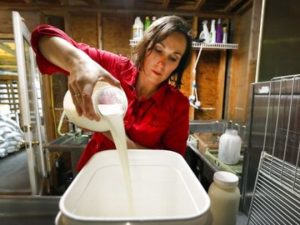In May 2018, five children at Pam Walker’s day care in Tenn. were stricken with E. coli O157.
 Kristi L Nelson of Knox News reports that science, public health officials said, sleuthed out the source of the E. coli infection: a goat farm across the road.
Kristi L Nelson of Knox News reports that science, public health officials said, sleuthed out the source of the E. coli infection: a goat farm across the road.
But for Walker, there’s been no closure — and she may never get the answers to exactly how a microorganism turned her dream of a bucolic child care center in a farm setting to a weeks-long nightmare.
Meanwhile, the health department was already investigating an E. coli outbreak among 10 children who’d consumed raw milk from a nearby dairy, French Broad Farms. Because it would be so unusual for two different E. coli O157 outbreaks to occur in the same area simultaneously, the health department, in the course of extensive interviews, looked for a link between Kids Place and the dairy. Did any children at the day care drink raw milk? Socialize or swim with anyone in the other group of infected children? Did any person or animal go back and forth between the dairy and the day care? The answers, they found, were no.
“Finding a bacteria that is microscopic, not visible to the naked eye, is really, really challenging,” said health department Director Dr. Martha Buchanan. “You have got to get the right sample at the right spot. And environmental cleaning did happen — the environment had changed when they went back” to sample.
With the positive culture from goat feces, the health department’s investigators determined that bacteria from the goats had somehow gotten into the baby house — and probably would have been present there before cleaning. When the specimens were sent back to the Tennessee Department of Health for DNA comparison with stool samples from the sick children, the DNA “fingerprint” from the goat samples and the Kids Place children were an exact match — but different from the DNA “fingerprint” of the cow feces from the dairy and the children who’d consumed raw milk, which matched each other. That meant, though unusual, that Knox County had two separate E. coli outbreaks in young children happening at the same time.
Finding it in goat feces, however, wasn’t a surprise. Goats, cows, sheep and other “ruminant” animals — animals that have a multichambered stomach and regurgitate and rechew food before digesting it — often carry E. coli in their digestive tracts. They can carry the bacteria, and shed it through their feces, but it typically doesn’t make them sick.
“Given that some of these illnesses have been linked to the goats at your facility, I recommend you no longer keep goats or other ruminant animals on your property, or that those who interact with the goats do not have contact with the children in your care,” Buchanan told Walker in a July 6 letter.
After the outbreak, Walker gave the goat herd to a friend. But the week after the health department informed her of the test results, she and her husband contacted the University of Tennessee College of Veterinary Medicine to have the goats tested again for E. coli. Dr. Marc Caldwell, assistant professor in large animal clinical sciences, remembers the test being requested merely to see if the goats were healthy, but Steve Walker said he wanted to see if this second test also would find a DNA fingerprint match between his goats and the children’s stool samples.
Techs from UTVM swabbed the goats themselves for fecal samples, rather than collecting feces from the ground as the health department did, and sent them to the Nebraska lab for culture. None of the goats tested positive for E. coli, but both herd dogs — also swabbed — did, while the health department’s dog feces samples were negative. It’s unusual, but possible, for dogs to carry E. coli, Caldwell said.
Caldwell said the test doesn’t prove the animals didn’t have E. coli O157 when the health department tested the feces. In fact, it doesn’t prove they didn’t have it that week, since the amount of bacteria shed from an infected animal can depend on heat, stress and other factors, and a certain amount has to be present for the antigen test — which is what the lab used — to show positive.











